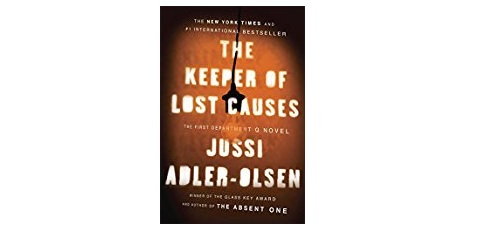
Book Review: The Keeper of Lost Causes by Jussi Adler-Olsen
Jussi Adler-Olsen Pushes You to the Edge in “The Keeper of Lost Causes”
After reading The Keeper of Lost Causes: The First Department Q Novel (A Department Q Novel), a crime thriller set in Denmark, I understand why author Jussi Adler-Olsen has received so many accolades for his work. If you’re a fan of Jo Nesbo or Henning Mankell, you’re about to meet another fine writer who wields a skillful pen, crafts a clever story and creates maddeningly endearing characters that leave you wanting more.
In The Keeper of Lost Causes, Adler-Olsen introduces us to Carl Morck, a traumatized detective in the Copenhagen’s homicide division. Morck, a 25-year police veteran, has just survived a shooting that has claimed the life of one of his partners and paralyzed the other.
Now, barely recovered himself, and haunted with survivor’s guilt, he’s bitterly afloat in the machinations of police life. Rumor and innuendo surround the circumstances of the shooting. His colleagues avoid him. He’s angry, rude, caustic and viewed by some as a walking time bomb that should be let go.
No one is more surprised than Morck when, rather than receiving termination papers, he is promoted to head up the department’s newly formed cold case division, Department Q. He’s given a handful of unsolved cases that have been open for years, along with meager support staff and a tiny office in the basement of the building, away from everyone else. What looked like a promotion on paper is actually a move to maneuver him away from the rest of the department. It suits his black mood just fine.
At the same time Adler-Olsen is letting us get to know Carl Morck, he’s also adroitly introducing two crime scenes, one in the present and one in the distant past. At first it’s difficult to understand why he’s chosen these two cases for the book, but that’s the deliciousness of Adler-Olsen’s storytelling. We learn more about Morck through his reaction to each of the cases.
We see how Morck, as focused as he is on the cold case, can’t stop himself from meddling in a murder case being worked by his co-workers. We watch and cringe as he caustically questions the work performed by the detectives initially assigned to his cold case, regardless of the political fall-out. And we sorrow for him as he doggedly shows up at the hospital to visit his paralyzed partner, no matter how much he wants to run away.
Morck’s first cold case is not a confirmed murder, but a missing persons case that is now five years old. The victim, a young woman, had disappeared while on a ferry boat ride with her mentally disabled brother. Was she abducted or did she run away? No one can say for certain.
As Morck digs through the clues, he begins to question whether she is even dead. Holding out little hope in this regard, he is tenacious in his goal to solve unanswered questions in the case so that ultimately, the victim’s fate is truly known. It is his approach to this cold case that shows us what how devoted Morck truly is to finding justice for his victims regardless how much time has passed.
As events unfold, it becomes clear that the perpetrators are alive and more ruthless than anyone could imagine. Adler-Olsen shares the victim’s fate one chilling vignette at a time, and when Morck begins to close in on the truth, it’s clear that he’s still very damaged from the shooting and at risk. He may not survive this case.
Adler-Olsen lets the story and the tension unfold, one delicate layer at a time, until I felt my own heart beating fast and hard as Carl Morck’s as he closes in on the answers he’s hunting. I won’t tell you more, except to say this is a book you won’t be able to put down until you reach the end.
In the The Keeper of Lost Causes, we meet a tenacious, damaged detective for whom thankfully, no one is forgotten. I’d want him on my side.
I’m glad this is the first in a series of six novels that are available in English as well as Danish.
Copyright © Paula Heikell. All rights reserved.



No Comments